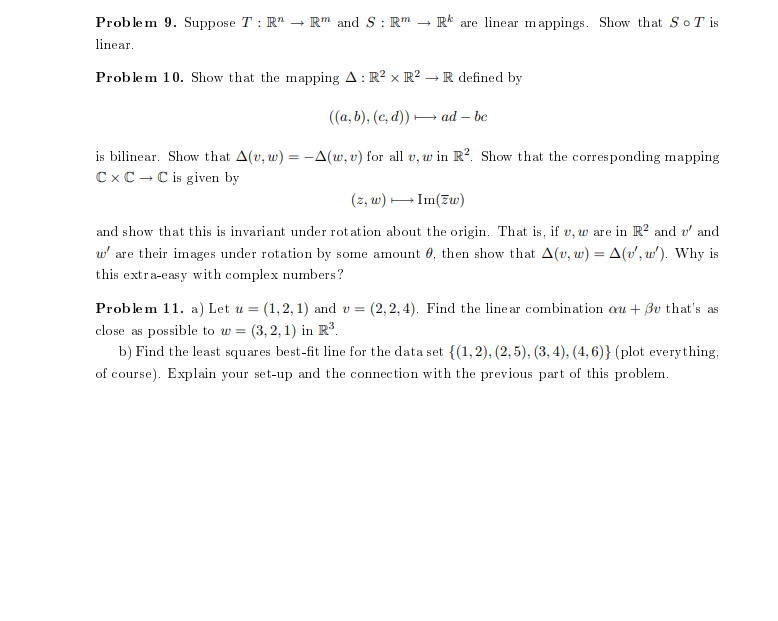Problem 10. Show that the mapping A: R² x R² → R defined by ((a, b), (c, d)) → ad – be is bilinear. Show that A(v, w) = -A(w, v) for all v, w in R². Show that the corresponding mapping Cx C- C is given by (z, w) – Im(Zw) and show that this is invariant under rot ation about the origin. That is, if v, w are in R² and v' and w' are their images under rotation by some amount 0, then show that A(v, w) = A(v', w'). Why is %3D this extra-easy with complex numbers?
Problem 10. Show that the mapping A: R² x R² → R defined by ((a, b), (c, d)) → ad – be is bilinear. Show that A(v, w) = -A(w, v) for all v, w in R². Show that the corresponding mapping Cx C- C is given by (z, w) – Im(Zw) and show that this is invariant under rot ation about the origin. That is, if v, w are in R² and v' and w' are their images under rotation by some amount 0, then show that A(v, w) = A(v', w'). Why is %3D this extra-easy with complex numbers?
Elementary Linear Algebra (MindTap Course List)
8th Edition
ISBN:9781305658004
Author:Ron Larson
Publisher:Ron Larson
Chapter6: Linear Transformations
Section6.2: The Kernewl And Range Of A Linear Transformation
Problem 64E
Related questions
Question
Can you solve #10?

Transcribed Image Text:Problem 9. Suppose T : R" –→
Rm and S : Rm
R* are linear mappings. Show that So T is
linear.
Problem 10. Show that the mapping A: R? x R² → R defined by
((a, b), (c, d)) – ad – be
is bilinear. Show that A(v, w) = –-A(w, v) for all v, w in R?. Show that the corresponding mapping
C x C -C is given by
(z, w) - Im(Zw)
and show that this is invariant under rot ation about the origin. That is, if v, w are in R? and v' and
w' are their images under rotation by some amount 0, then show that A(v, w) = A(v', w'). Why is
%3D
this extra-easy with complex numbers?
Problem 11. a) Let u =
(1,2, 1) and v = (2, 2,4). Find the line ar combination au + Bv that's as
close as possible to w =
b) Find the least squares best-fit line for the data set {(1,2), (2, 5), (3, 4), (4, 6)} (plot everything,
(3, 2, 1) in R³.
of course). Explain your set-up and the connection with the previous part of this problem.
Expert Solution
This question has been solved!
Explore an expertly crafted, step-by-step solution for a thorough understanding of key concepts.
This is a popular solution!
Trending now
This is a popular solution!
Step by step
Solved in 3 steps with 3 images

Recommended textbooks for you

Elementary Linear Algebra (MindTap Course List)
Algebra
ISBN:
9781305658004
Author:
Ron Larson
Publisher:
Cengage Learning

Elementary Linear Algebra (MindTap Course List)
Algebra
ISBN:
9781305658004
Author:
Ron Larson
Publisher:
Cengage Learning